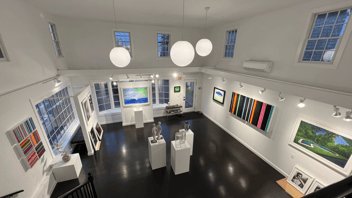Lessons from Matisse and Naval
“Escape competition through authenticity. No one can compete with you on being you.” - Naval Ravikant

Naval is my favorite contemporary thinker. Wisdom from his Navalmanack has come up in almost every meaningful conversation I’ve had over the past few years. In one of the chapters of that text, he argues the idea that you should always be optimizing to ‘be yourself’. No one can compete with you. Because for you, being you is play. Everything is effortless. If someone is copying you — it’s work for them.
I’ve held this value in my heart throughout the years we’ve been building ArtCloud. Our souls are in this company. If another platform wants to copy a feature it’s so obvious that that’s all they’ve done. On the surface, the form might appear identical, but the hours we’ve spent ideating, experimenting, and collaborating cannot be easily replicated. A closer look almost always reveals a far more integrated and robust version of the feature other platforms have introduced as though checking a box.
The question of whether a chapel should be a competition is for another essay that I have no authority to write, but I will say that after visiting Matisse’s chapel in St Paul de Vance, no one else in the world could have created such a structure.
The Matisse Chapel, also known as the Chapel of the Rosary (Chapelle du Rosaire) in Vence, France, is authentic for several reasons:

1. Designed by Henri Matisse: The chapel was entirely designed by the renowned French artist Henri Matisse, making it one of the few religious buildings created by a modern artist. Matisse worked on the project from 1947 to 1951, near the end of his life.
2. Integration of Art and Architecture: Matisse not only designed the building’s structure but also created its stained glass windows, murals, furnishings, and liturgical objects. His involvement in every aspect of the design results in a harmonious integration of art and architecture.
3. Use of Color and Light: The chapel is famous for its vibrant stained glass windows, which fill the interior with colored light. Matisse used a limited color palette—mainly blues, greens, and yellows—to create a serene and spiritual atmosphere.
-
4. Innovative Design: The chapel’s design is minimalist and modern, with white walls that emphasize the bold colors of the stained glass. The simplicity of the space allows the artworks to stand out and allows visitors room for quiet contemplation, contributing to the overall spiritual experience.
But even Matisse, early in his career, developed and honed his craft by imitating others. One of his first mentors was the Classicist Gustave Moreau, known for sending his students to the Louvre to replicate the works of Old Masters. Moving on from this practice, Matisse still spent years imitating the style — if not the content — of contemporaries like Van Gogh and Cézanne, all before painting his first major work. That painting, 1905’s Woman with a Hat, looked like nothing else the art world had seen. Its loose brush strokes and loud, conflicting colors broke away almost entirely from the traditional artistic conventions the artist had spent years studying and is now considered to be the seminal work of Fauvism. Of his youthful imitation of other artists, Matisse explained:
| "I have never avoided the influence of others... I believe that the personality of the artist develops and asserts itself through the struggles it has to go through when pitted against other personalities." |
Rather than copying, Matisse was interrogating the practice of his peers, developing an intimate understanding of the kind of artist he was not.
In both technology and art, authenticity is the ultimate differentiator. Just as Matisse's chapel is irreplaceable because it is a pure expression of his soul and life’s journey, so too should we strive to build things that only we can create—works that are uniquely ours. Whether it’s a new software feature or a masterpiece of modern art, the essence of its greatness lies not in superficial qualities but in the depth of authenticity, effort, and thought behind it. This is the path to true, unshakable success: not through competition, but through the constant evolution of our truest selves.

In a world obsessed with comparison, authenticity is the one area where no one can compete with you. So, let others imitate. Meanwhile, we’ll continue to build, experiment, and innovate from a place that feels effortless, because it’s inherently us.
There are copycats in the art world. Artists ripping others off, galleries recruiting the same artists as their peers.
Artists and galleries would be well served to heed this advice and remember they are special, and no one can compete with them being them.
Learn more about ArtCloud here, and if you'd like to tour our business operations software for galleries, please schedule a demo.


























